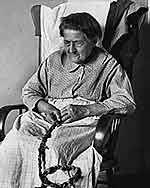By Dan Gunderson and Chris Julin
Minnesota Public Radio
July 29, 2002
| |
|
|
|
||
In the mid-1800s there was no welfare system, just something called "outdoor relief."
Elected officials of the county or town dealt with each request for help. If they thought the person really needed help, they'd dole out a few dollars for food or shelter.
The system was confusing and expensive, so governments established poorhouses patterned after the almshouse of Elizabethan England.
Michael Katz has written articles and books about the history of welfare. He teaches history at the University of Pennsylvania. Katz says the idea behind the poorhouse was simple - discourage people from asking for help by forcing them to work for food and shelter.
Katz says the poorhouse was an abject failure.
"It didn't cut down on outdoor relief," he says. "Outdoor relief kept growing. Second thing is they were incredibly expensive. It cost far more to keep somebody in one of these poorhouses than to help them with a little bit of food or shelter. Third, it proved impossible to put the inmates to work."
Katz says many people were at the poorhouse because they couldn't work.
In rural areas, many poorfarms had a vegetable garden, and kept a few chickens, hogs and cows. Sometimes they raised enough food to feed the residents, but counties quickly had to give up on the idea that poorhouses could pay for themselves.
| |
|
|
|
||
"The poorhouse was the most stigmatized of public institutions, and it's one we seem to want to forget," Katz says.
Maybe, Katz says, that's why most historians have ignored the poorhouse.
"For some reason, it seems to offend our sensibilities - and our image of what this country was - so much, that we have suppressed it," he says.
But Michael Katz still sees shadows of the poorhouse, and he hears echoes of the thinking that created the poorhouse system.
Early poorhouses were catchalls for anyone who was down and out, a lot like homeless shelters today. In the 1800s, counties tried to separate the "worthy poor" from the "unworthy." They used those very words.
People decided orphans were "worthy," so they built orphanages. Then they built asylums for the mentally ill. Poorhouses became places for old people.
Michael Katz says it's still hard to agree who deserves help and who doesn't. He says it's easier for poor people to find food and shelter and medical care than it was 100 years ago, but there's a still a strong tendency to blame them for being poor.
Next: Today's poor - better off?


